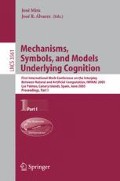Abstract
Many approaches to anticancer treatment have had a limited success. A fundamental hurdle to cancer therapy is the robustness of the signalling networks involved in tumourgenesis. The complexity of networks of biological signalling pathways is such that the development of simplifying models is essential in trying to understand the wide-ranging cellular responses they can generate. In this paper a model of the epidermal growth factor receptor signalling cascade is developed using continuous membrane systems. This model is used to study the robustness of this signalling cascade which is known to play a key role in tumour cell proliferation, angiogenesis and metastasis.
Access this chapter
Tax calculation will be finalised at checkout
Purchases are for personal use only
Preview
Unable to display preview. Download preview PDF.
References
Ciobanu, G., Păun, G., Pérez-Jiménez, M.J. (eds.): Applications of Membrane Computing. Springer, Heidelberg (2005) (in press)
Cordón-Franco, A., Sancho-Caparrini, F.: Approximating non-discrete P systems. In: Mauri, G., Păun, G., Jesús Pérez-Jímenez, M., Rozenberg, G., Salomaa, A. (eds.) WMC 2004. LNCS, vol. 3365, pp. 287–295. Springer, Heidelberg (2005) (in press)
El-Masri, H.A., Portier, C.J.: Replication Potential of Cells via the Protein Kinase C-MAPK pathway: Application of a Mathematical Model. Bulletin of Mathematical Biology 61, 379–398 (1999)
Kholodenko, B.G., et al.: Quantification of Short Term Signalling by the Epidermal Growth Factor Receptor. J. Biol. Chem. 274, 30169–30181 (1999)
Miller, J.H., Zheng, F.: Large-scale Simulations of Cellular Signaling Processes. Parallel Computing 30, 1137–1149 (2004)
Moehren, G., et al.: Temperature Dependence of the Epidermal Growth Factor Receptor Signaling Network Can Be Accounted for by a Kinetic Model. Biochemistry 41, 306–320 (2002)
Nishida, T.Y.: Simulations of Photosynthesis by a K-Subset Transforming System with Membranes. Fundamenta Informaticae 49(1), 101–113 (2002)
Păun, A., Păun, G.: The Power of Communication: P Systems with Symport/Antiport. New Generation Computing 20(3), 295–305 (2002)
Păun, G.: Computing with Membranes. Journal of Computer and System Sciences 61(1), 108–143 (2000)
Păun, G.: Membrane Computing. An Introduction. Springer, Berlin (2002)
Pérez-Jiménez, M.J., Romero-Campero, F.J.: Modelling EGFR Signalling Network using Continuous Membrane Systems, Accepted paper in the Workshop on Computational Methods in Systems Biology (2005)
Plank, M.J., Sleeman, B.D.: Tumour-Induced Angiogenesis: A Review. Journal of Theoretical Medicine (in press)
Schoeberl, B., et al.: Computatinal Modeling of the Dynamics of the MAP Kinase Cascade Activated by Surface and Internalized EGF Receptors. Nature Biotech. 20, 370–375 (2002)
Sermon, B.A., et al.: The Importance of Two Conserved Arginine Residues for Catalysis by the Ras GTPas-activating Protein, Neurofibromin. The Journal of Biological Chemistry 273, 9480–9485 (1998)
Starbuck, C., Lauffenburger, D.A.: Mathematical Model for the Effects of Epidermal Growth Factor Receptor Trafficking Dynamics on Fibroblast Proliferation Responses. Biotechnol. Prog. 8, 132–143 (1992)
Sydor, J.R., et al.: Transient Kinetic Studies on the Interaction of Ras and the Ras-Binding Domain of c-Raf-1 Reveal Rapid Equilibration of the Complex. Biochemistry 37, 14292–14299 (1998)
Wiley, H.S.: Anomalous Binding of Epidermal Growth Factor to A431 Cells is Due to the Effect of High Receptor Densities and a Saturable Endocytic System. The Journal of Cell Biology 107, 801–810 (1988)
ISI web page, http://esi-topics.com/erf/october2003.html
P systems web page, http://psystems.disco.unimib.it/
Author information
Authors and Affiliations
Editor information
Editors and Affiliations
Rights and permissions
Copyright information
© 2005 Springer-Verlag Berlin Heidelberg
About this paper
Cite this paper
Pérez-Jiménez, M.J., Romero-Campero, F.J. (2005). A Study of the Robustness of the EGFR Signalling Cascade Using Continuous Membrane Systems. In: Mira, J., Álvarez, J.R. (eds) Mechanisms, Symbols, and Models Underlying Cognition. IWINAC 2005. Lecture Notes in Computer Science, vol 3561. Springer, Berlin, Heidelberg. https://doi.org/10.1007/11499220_28
Download citation
DOI: https://doi.org/10.1007/11499220_28
Publisher Name: Springer, Berlin, Heidelberg
Print ISBN: 978-3-540-26298-5
Online ISBN: 978-3-540-31672-5
eBook Packages: Computer ScienceComputer Science (R0)

